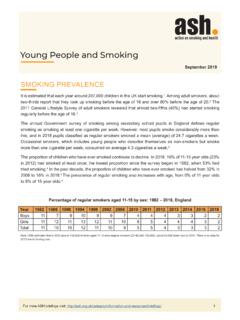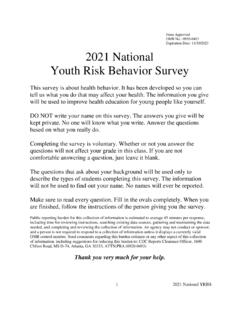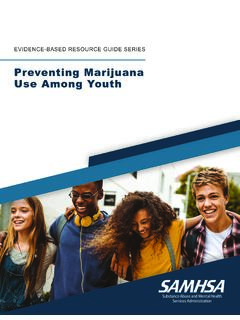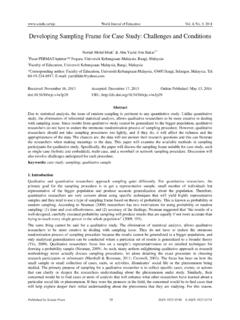Transcription of VISION MISSION GOAL AND OBJECTIVES - World Health …
1 VISION MISSION GOAL AND OBJECTIVES 3. VISION , MISSION , Goal and OBJECTIVES VISION To create a tobacco -free society MISSION To promote individual, community and government responsibility to prevent and reduce tobacco use through multi-sectoral participation in tobacco control. Goal To reduce mortality and morbidity due to the use of tobacco . Main OBJECTIVES The National Action Plan on tobacco Control is guided by three main OBJECTIVES : To prevent the use of tobacco among young people and adults.
2 This main objective has two SMART* sub- OBJECTIVES : a. To reduce the prevalence of smoking among male adults aged 20 years and above from 36 % in 2004 to % in 2012. b. To reduce the prevalence of smoking among adolescents aged 13-15 years from 15 % in 2003 to 10 % in 2012. To protect from exposure to environmental tobacco smoke (ETS). This main objective has two SMART* sub- OBJECTIVES : To decrease the percentage of non-smoking adolescents aged 13-15 years who are exposed to tobacco smoke in public places from 60 % in 2003 to 45% in 2012.
3 By 2012, 75 % of indoor places will be compliant to regulations on environmental tobacco smoke. *SMART stands for Specific, Measurable, Achievable, Realistic and Time-bound To promote cessation among smokers. This main objective has two SMART* sub- OBJECTIVES : By 2012, 75 % of patient smokers attending public Health service will be routinely counselled and followed-up by Health care providers. By 2012, 20 % of high risk patient smokers attending public Health service will be put on drug therapy to quit smoking.
4 Specific OBJECTIVES Each main objective has a number of specific OBJECTIVES which are listed and justified below: Main objective: To prevent the use of tobacco among young people and adults. Specific OBJECTIVES : a. To increase public awareness on the consequences of tobacco use. b. To increase anti- tobacco policies and programmes in schools. c. To reduce access to tobacco products to minors. d. To reduce access to tobacco products through illicit trade. e. To increase the price of tobacco products.
5 F. To reduce the influence of the tobacco industry on young people and adults. Main objective: To protect from exposure to environmental tobacco smoke (ETS). Specific OBJECTIVES : a. To increase awareness on the harmful effects of ETS. b. To control the contents and emissions of tobacco products. c. To reduce exposure to environmental tobacco smoke in indoor and outdoor public places. *SMART stands for Specific, Measurable, Achievable, Realistic and Time-bound Main objective: To promote cessation among smokers.
6 Specific OBJECTIVES : a. To increase awareness and the intention to quit among smokers. b. To increase awareness among Health professionals on smoking cessation programmes. c. To provide treatment for tobacco dependence. In order to develop appropriate performance indicators to evaluate the implementation of the Action Plan and to monitor the outcomes of the related activities, it is required to strengthen the surveillance and evaluation system. JUSTIFICATION 4. JUSTIFICATION Specific objective: To increase public awareness on the consequences of tobacco use There is strong scientific evidence that tobacco is injurious to Health .
7 tobacco is known to contain more than 4,000 chemical substances, out of which more than 50 are carcinogens. Smoking is responsible for 90% of all lung cancer, 75% of chronic bronchitis and emphysema and 25 % of ischaemic heart disease cases. It is harmful both to the smoker and the non-smoker who is exposed to sidestream smoke. In Mauritius, it is estimated that around 1000 deaths yearly are directly attributable to the use of tobacco . The economic burden of tobacco use on families cannot be overlooked as money needed for food, Health , clothing, housing and other basic necessities of life is often spent on tobacco products.
8 Information remains a key element in confronting the epidemic of tobacco use. It encourages smokers to quit smoking and non-smokers not to take it up. It helps young people to dissipate perceptions such as smoking makes them fashionable, manly and attractive. It also helps people to understand the subtle strategies used by the tobacco industry to influence their behaviour and project a positive public image. Information is a powerful advocacy tool that serves to influence policies for stronger anti- tobacco regulations.
9 Specific objective: To increase anti- tobacco policies and programmes in schools. The Global youth tobacco survey of 2003 shows that experimentation with tobacco starts early in life, the most common age being 12-13 years both in Mauritius and Rodrigues. It is also noted that of school children in Mauritius and in Rodrigues first tried their cigarettes at 7 years or younger. These findings dictate early interventions among children in order to increase their knowledge, influence their attitudes and behaviours and help them develop appropriate skills.
10 Education up to the age of 15 years being compulsory in Mauritius, children have to attend primary school for a minimum of 6 years and secondary school for a minimum of 3 years. The school thus provides the best opportunity to reach children and adolescents with anti- tobacco education in a gradual and comprehensive manner. At a time when it is becoming increasingly difficult to reach young people outside of schools due to a number of factors- more games and entertainment at home, internet caf s, video games outlets, private tuition- the school remains the ideal setting where anti- tobacco education could be imparted to young people.

















